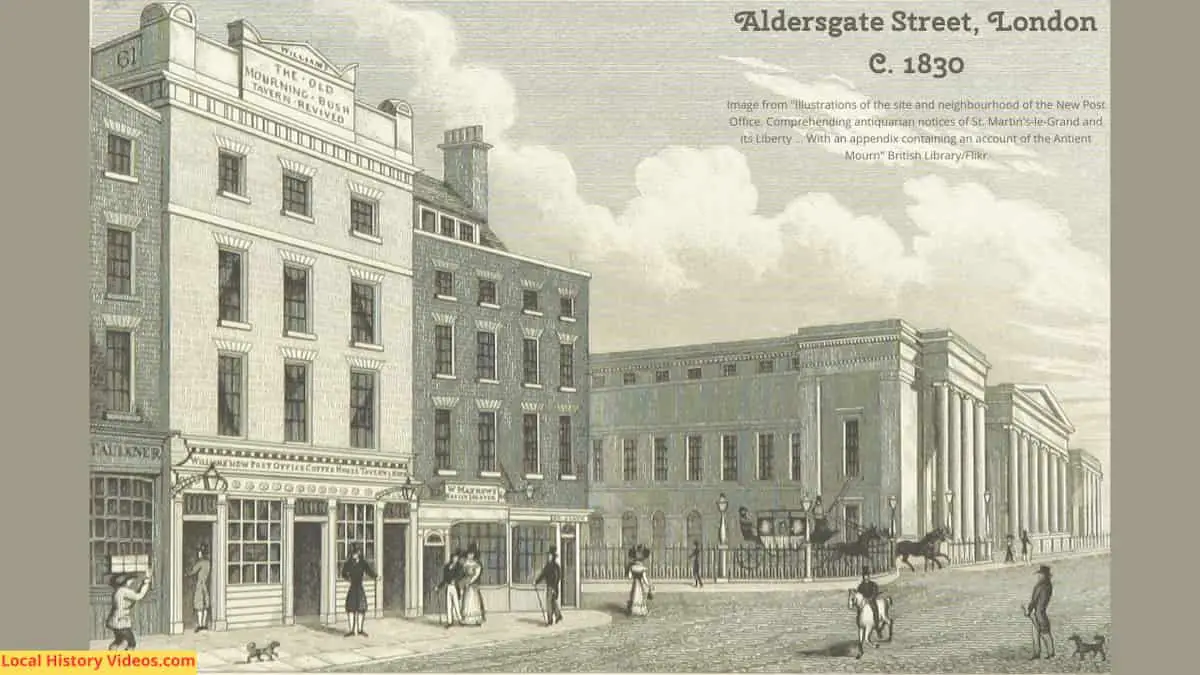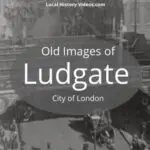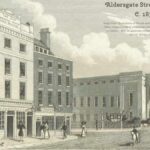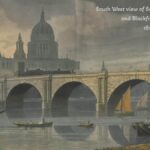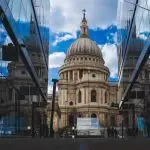Glimpse history through old images of Aldersgate, in the City of London.
Aldersgate was a gate in the northern part of London’s defensive city walls. It was added during the later Roman period, into the city walls which had been built around 200AD.
The first known mention of it calles the gate Ealdredesgate, a gate named after a man with the Saxon name Ealdrād.
Aldersgate was also the name of one of the wards of London, which were administrative, judician and military bodies established before the Norman Conquest of England and Wales in 1066. Not surpringly, this ward’s role was to defend the Aldersgate, and some of the land within the city walls.
Later, the population grew beyond the city walls, and the ward did too. Aldersgate Bars, which mark the boundary beyond the walls, were first recorded in 1197.
The two parts became known as Aldersgate Within, for the land within the city walls, and Aldersgate Without, for the land beyond the walls.
Aldersgate Road ran through Aldersgate Without, and was the road to Clerkenwell.
John Blytone, earliest sword-bearer of the City of London, resigned from the service of the Lord Mayor of London in 1395. He was granted the “Gate of Aldrichgate” to live in.
James VI of Scotland inherited the English crown in 1603. Coming down from Scotland for his coronation as King James I of England, he entered the city of London through Aldersgate. Special statues were created to welcome him. The statues outside the city walls showed him on horseback, while the ones inside portrayed him sitting on the throne.
In 1617, Aldersgate was taken down, and rebuilt the same year. Gerard Christmas designed the new gate.
Repairs were needed in 1666, when the Great Fire of London damaged the gate.
In 1761, the gate was again removed.
From the 18th Century, the Bishop of London’s chapel was located in Aldersgate Street , along with his chambers at London House. The site was more conveniently placed for access to St Paul’s Cathedral than the official Bishop’s Residence at Fulham.
Lost Buildings of Aldersgate
- Collegiate church and sanctuary founded in 750 by Withu, King of Kent, hugely expanded in 1056 by Ingebrian, Earl of Essex, issued with a royal charter in 1068 by William the Conqueror; demolished in 1818 for the headquarters of the General Post Office
- Headquarters of the General Post Office; built in the late 1820s and demolished shortly after its closure in 1910
- Adjoining Postman’s Park
- World War II bombs destroyed or damaged most buildings on Aldersgate Street
- Manchester Hotel, 240 rooms, built in 1879, used to house Jewish refugees from Poland and Belgium; demolished after damage from World War II bombs
While the walls, gate, and historic buildings have long since disappeared, Aldersgate today is home to the Barbican, making it one of the two primarily residential wards in the City of London, a central part of the modern capital city.
Multi Storey Garage 1961
In 1961, a new multi storey garage was opened in Aldersgate Street, and the opening day was recorded on film.
Much of the footage focuses on William Meyers, the owner, and Lord Mayor Sir Waley Cohen who arrives in a Rolls Royce.
There are also glimpses of the other people attending the opening event. There’s quite a few of them.
However, the rooftop views catch the eye, especially at 2:38.
And the price list is good for a chuckle. Most of it, being in old money, makes no sense to anyone under their mid-50s. But we can all spot the monthly offer of £5 for an unrestricted parking permit!
Multi-Storey Garage Opened At Aldersgate Street (1961) – British Pathé on YouTube
An Old Book About Aldersgate
Extract from: “Illustrations of the Site and Neighbourhood of the New Post Office Comprehending Antiquarian Notices of St. Martin’s-le-Grand, and Its Liberty, and the Adjoining Parishes of St. Anne, St. Agnes, and St. John, Zachary, with an Appendix, Containing an Account of the Antient Mourning Bush Tavern, & C. Aldersgate. And Various London Taverns, Its Contemporaries”, by William Herbert
Published in 1830
Page 44 – 45
That the Mourning Bush, or rather the Bush Tavern, existed ages before the anecdote alluded to, there are various evidences besides the antiquity of its foundations, though we have no means of ascertaining its precise age.
The sign alone, would rank it amongst the earliest London taverns, as the affixing the ivy – bush at the door, we see was a practice of remote date, and when used as the only sign of the house it was attached to, it marked in it a still higher date.
Considering then, that the alteration by its loyal owner alone carries us back nearly two centuries, and that it was at this period no doubt, an old house, it will not at all be assuming too much to suppose the bush might have been coeval with the most flourishing times of St. Martin’s – le – grand College.
This conjecture is strengthened by reverting to the then state of the neighbourhood, and the utility such a house must have been of, so situated.
When Aldersgate Street was a mere country road from the north parts of the kingdom, bounded on its west side the whole distance between Long Lane and Little Britain, by Bartholomew priory wall, and the numerous alder trees which are said to have given this thoroughfare its name ; and, on its opposite side, equally dreary, was only the great burial ground of the Jews, with scarcely a cheerful dwelling ; a house for refreshment immediately the traveller entered the city gate might be reasonably expected ; and where could such a house be so appropriately situated, as between St. Anne’s Church and the gate?
All the space on the other side was occupied with Northumberland house and gardens the town mansion of the gallant Percies ; that is to say, when they were in town : for the business of these great peers, was chiefly in the camp, as Pennant observes, “which they seldom quitted for London, but to brave the sovereign or the favorite.”
What public houses there were within St. Martin’s Liberty, being “sanctuary,” would be closed at nine o’clock at night, with the closing of the college gates.
We repeat, therefore, where could the traveller on entering town from the great north road, be likely to be more commodiously and readily suited – as he may still – than at the Bush, which besides its convenient situation, pleasantly overlooking the “Dean’s Garden,” must have enjoyed an atmosphere as unconfined and salubrious, as it does now from the open and magnificent area of the New Post Office.

